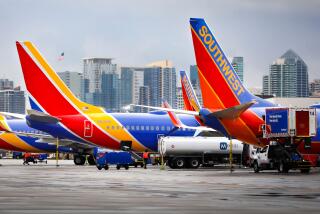Know the Drill on Dental Emergencies
- Share via
Somewhere over Kansas, the tooth you thought had a lifetime filling begins to throb. During dinner on your Caribbean cruise, what you thought was a piece of raw broccoli turns out to be the crown you just had replaced.
“All it takes for a dental emergency is one piece of seven-grain bread,” says Matthew Messina, a Cleveland dentist and consumer advisor for the American Dental Assn. He recently cared for a woman who was eating seven-grain bread when a kernel of grain lodged under a tooth and caused her gums to become inflamed.
That’s easily fixed when your dentist is in the neighborhood, but not as easy to treat if you’re halfway around the world.
Knowing which common dental emergencies can be self-treated, at least temporarily, and which need immediate attention is half the solution. The other half is taking along proper first-aid supplies.
Before you take off, slip your dentist’s business card into your suitcase, Messina advises. He often does a phone consultation with traveling patients and gets them stabilized by calling in a prescription or referring them to a dentist he knows in the location.
Most dental associations are willing to help travelers find dentists, according to the American Dental Assn. The FDI World Dental Assn. lists member associations in various countries (Internet https://www.fdi.org.uk/members/index.htm).
In Messina’s experience, the most common dental emergencies on the road involve irritation as a result of food lodging in the gums or an infection of the tooth or gums. Often, if a patient telephones him and describes what is obviously an infection, Messina will call in a prescription for antibiotics.
Tooth fractures are probably next most common, he says. If the fracture involves the tooth root, the patient will require immediate care to ease the considerable pain. Also common are dislodged crowns or fillings, broken dentures or problems with orthodontia.
A little dental first-aid know-how goes a long way. Here are suggestions from Messina and the American Dental Assn. (ADA):
* If a tooth is knocked out, retrieve it and rinse off any debris, being careful to hold it by the crown and not the root. If you can, put it back in the socket. If not, put it in a container of milk. Get to a dentist as quickly as possible--within 30 minutes is best, the ADA says. “Two hours is the outside limit,” Messina says.
* If you have broken a tooth, rinse your mouth with warm water, use cold compresses to keep the swelling down and call a dentist as soon as possible.
* Warm water also can ease a toothache. Floss to remove any trapped food, which could be causing the pain.
* If a crown dislodges, put a bit of toothpaste inside it and put it back in place, Messina advises. Often the toothpaste will act as a temporary cement.
* If orthodontic wires are irritating, cover the ends with beeswax or orthodontia wax, sold in drugstores, or a cotton ball.
* If a filling falls out, temporary cements, which are sold at drugstores, can be used. Kits to repair broken dentures are also sold.
Several commercial dental emergency kits are available. Campmor (telephone [888] 226-7667, https://www.campmor.com) sells a kit for $15.99, packaged in a resealable bag that includes temporary filling material, an exam mirror, oil of cloves to use as an analgesic, gauze pads and emergency instructions. The Dental Kit for Travelers from St. John Dental (tel. [877] 336-8548, https://www.dentalkitfortravelers.com) costs $29.95 and includes an exam mirror, dental tweezers, wax, floss, filling material, crown and bridge cement, ointment for cold and canker sores, gauze and cotton balls and instructions. The tiny Tempanol Dental First Aid Kit, with filling material for lost fillings and loose crowns, toothache medicine and a container for a dislodged tooth or crown, is about $7 at drugstores.
Travelers can easily assemble their own kit. Among the suggested contents: floss, temporary cement, a denture repair kit, local anesthetics such as Anbesol or Orajel, cotton gauze, painkillers and anti-inflammatory medicine.
*
Healthy Traveler appears the second and fourth week of the month.
More to Read
Sign up for The Wild
We’ll help you find the best places to hike, bike and run, as well as the perfect silent spots for meditation and yoga.
You may occasionally receive promotional content from the Los Angeles Times.






